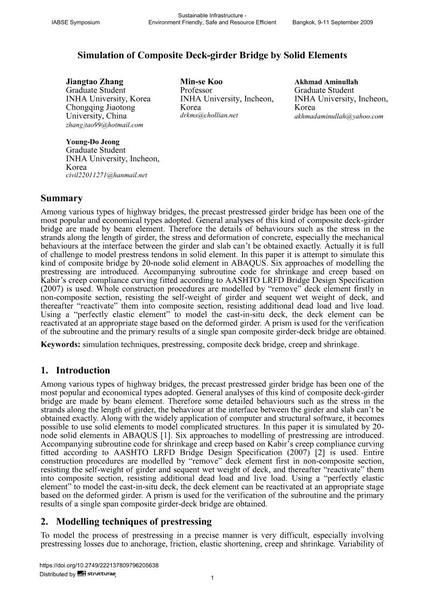Simulation of Composite Deck-girder Bridge by Solid Elements

|
|
|||||||||||
Bibliografische Angaben
| Autor(en): |
Jiangtao Zhang
Min-Se Koo Akhmad Aminullah Young-Do Jeong |
||||
|---|---|---|---|---|---|
| Medium: | Tagungsbeitrag | ||||
| Sprache(n): | Englisch | ||||
| Tagung: | IABSE Symposium: Sustainable Infrastructure - Environment Friendly, Safe and Resource Efficient, Bangkok, Thailand, 9-11 September 2009 | ||||
| Veröffentlicht in: | IABSE Symposium Bangkok 2009 | ||||
|
|||||
| Seite(n): | 35-44 | ||||
| Anzahl der Seiten (im PDF): | 8 | ||||
| Jahr: | 2009 | ||||
| DOI: | 10.2749/222137809796205638 | ||||
| Abstrakt: |
Among various types of highway bridges, the precast prestressed girder bridge has been one of the most popular and economical types adopted. General analyses of this kind of composite deck-girder bridge are made by beam element. Therefore the details of behaviours such as the stress in the strands along the length of girder, the stress and deformation of concrete, especially the mechanical behaviours at the interface between the girder and slab can’t be obtained exactly. Actually it is full of challenge to model prestress tendons in solid element. In this paper it is attempt to simulate this kind of composite bridge by 20-node solid element in ABAQUS. Six approaches of modelling the prestressing are introduced. Accompanying subroutine code for shrinkage and creep based on Kabir’s creep compliance curving fitted according to AASHTO LRFD Bridge Design Specification (2007) is used. Whole construction procedures are modelled by “remove” deck element firstly in non-composite section, resisting the self-weight of girder and sequent wet weight of deck, and thereafter “reactivate” them into composite section, resisting additional dead load and live load. Using a “perfectly elastic element” to model the cast-in-situ deck, the deck element can be reactivated at an appropriate stage based on the deformed girder. A prism is used for the verification of the subroutine and the primary results of a single span composite girder-deck bridge are obtained. |
||||
| Stichwörter: |
Vorspannung Kriechen und Schwinden
|
||||
